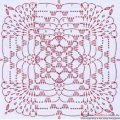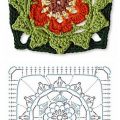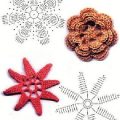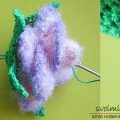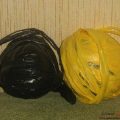Using flowers and leaves to decoratepeople from the very beginning of the world. In those old times plants were depicted on temples and palaces, certain kinds of flowers and leaves were used by shamans and priests of various cults. Plants were the symbols of many ancient gods. Certain types of flowers and leaves gave strength to bring luck, victory in battle, profit and even love. With the advent of needlework, their images were embroidered or tied on clothes or furnishings and were convinced of their miraculous power. Some beliefs about their magical properties have survived to this day, for example, the belief that the clover trefoil brings good luck. Now needleworms crochet leaves, as decor elements or parts of dress, shawls or other things. Openwork and dense products created by their own hands, show the whole world a miracle of skill and beauty. Shamrock clover.  A very simple scheme will be understandable even for beginners, and an elegant shamrock can be used as an element of Irish lace or to create a composition of three-dimensional colors.
A very simple scheme will be understandable even for beginners, and an elegant shamrock can be used as an element of Irish lace or to create a composition of three-dimensional colors.
Link a chain of 4 air. loops.
1 air. lifting loop, 1 tbsp. without a crocheting, 1 tbsp. with a cuff, in the extreme loop of the chain to tie 10 tbsp. with 2 covers.
To connect 2 more such pieces-leaves.
Link a chain of 8 air. loops.
1 air. lifting loop, knit 7 tbsp. Without a crochet, in the last loop of the chain connect the connecting bars with all 3 leaves.
A small sheet. 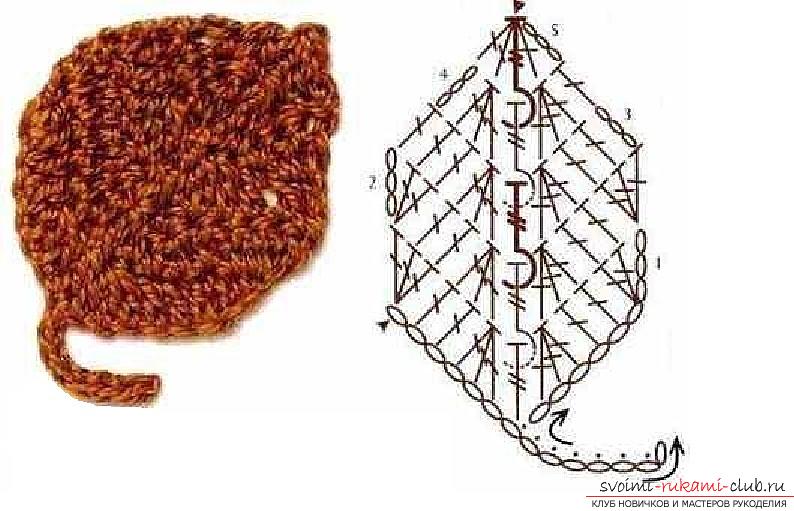 When knitting this leaf are used relief columns with 2 nakidami.
When knitting this leaf are used relief columns with 2 nakidami.
To knit a chain of 13 air. loops.
1 air. lifting loop, 7 tbsp. without a crochet (6 air loops remain unattached). To knit from the last st. without a crochet chain of 6 air. loops.
In one loop of the row below, tie 3 air. lifting loops + 2 tbsp. with a crochet, 2 tbsp. with a crochet, 3 tbsp. with a crochet with one top, 1 tbsp. with 2 nakidami in the seventh century. without a crochet, 3 tbsp. with a crochet with one top, 2 tbsp. with a crochet, 3 tbsp. with a crochet with one base.
In one loop to tie 3 air. lifting loops + 2 tbsp. with a crochet, 2 tbsp. with a crochet, 3 tbsp. with a crochet with one top, 1 concave column with 2 nakidami, 3 tbsp. with a crochet with one top, 2 tbsp. with a crochet, 3 tbsp. with a crochet with one base.
3 air. lifting loops, 2 tbsp. with a crochet, 3 tbsp. with a crochet with one top, 1 convex column with 2 nakidami, 3 tbsp. with a crochet with one top, 3 tbsp. with a crochet.
3 air. lifting loops, 3 tbsp. with a crochet with one top, 1 concave column with 2 nakidami, 3 tbsp. with a crochet with one top, 1 tbsp. with a crochet.
To knit with one vertex (3 lift loops, 1 st. With crochet, 1 convex column with 2 nakidami, 2 items with a crochet).
The relief columns are convex and concave. Convex raised relief. Make the necessary number of crochets, then enter the hook not into the loop, but from the right to the left into the column of the row below so that the "body" of the column of the bottom row is in front of the hook, pull out 1 loop and then knit like a regular column with a crochet. Concave column. Knit, as well as convex, but the "body" of the column of the lower row should be crocheted. Chestnut leaf. 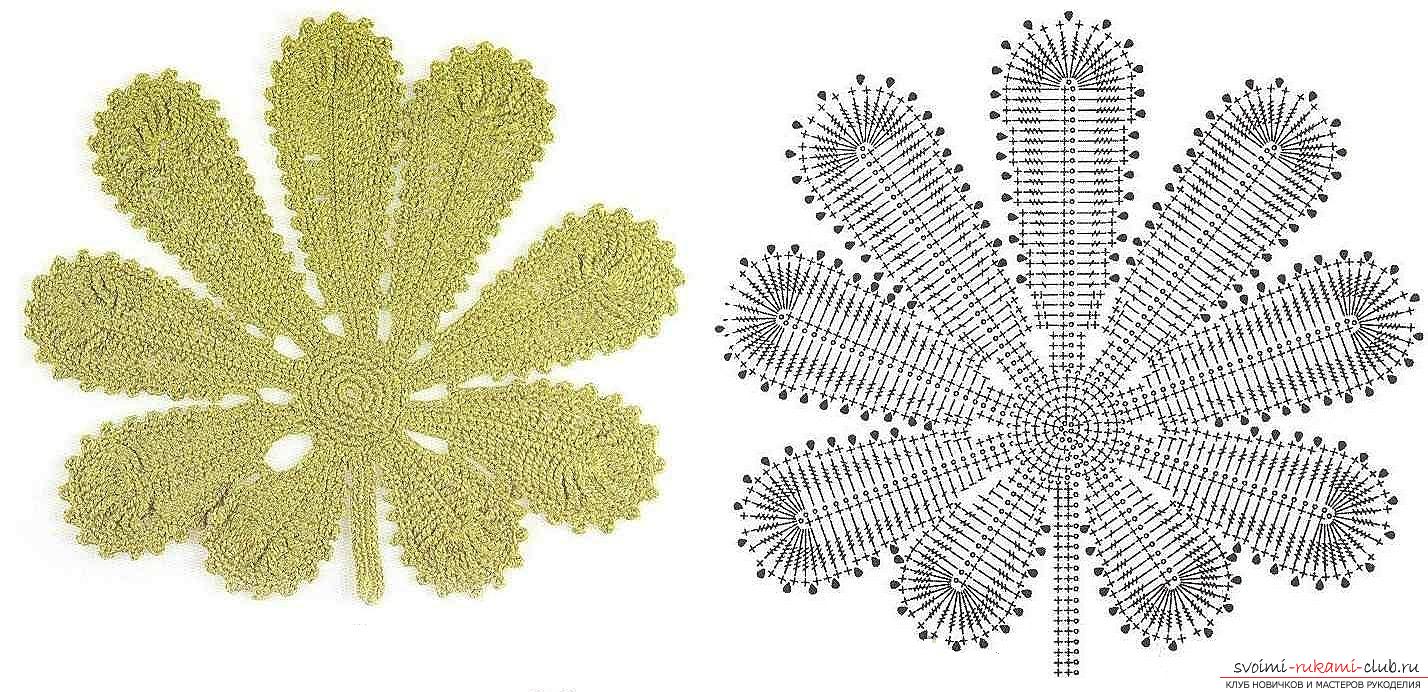 Starting from the 5th row of the middle, the petals kniteach separately. The length of the sheets varies due to the number of loops in the chain. For example, the smallest leaf is considered. Initially dialed from the chain of. for the petiole and the middle. Next, the middle knits in a circle in rows back and forth. Mid.
Starting from the 5th row of the middle, the petals kniteach separately. The length of the sheets varies due to the number of loops in the chain. For example, the smallest leaf is considered. Initially dialed from the chain of. for the petiole and the middle. Next, the middle knits in a circle in rows back and forth. Mid.
To knit a chain of 28 air. loops.
Close the chain in a ring of 4 air. loops.
First row. In the ring to bind 7 tbsp. without crock + 2 air. loops (the beginning and end of the series). Complete the series with a connecting post.
Second row. 1 air. lifting loop, 13 tbsp. without a crochet, 1 air. a loop. Finish the connecting post to the lifting loop.
The third row knit similarly, 20 tbsp. without crock + 2 air. loops.
Fourth row. Similarly, 24 tbsp. without crock + 2 air. loops.
Fifth row. 32 tbsp. without crock + 2 air. loops.
Chuck. To knead the remaining air. loops in 2 rows of st. without a crochet, each time tying up to the center a connecting post. Leaf. Right lower.
Link a chain of 13 air. loops and tie st. without a crochet, tie with a connecting post to the 3rd loop of the middle from the first row of the petiole.
Blend the connecting bar in the nextloop middle (instead of 1 lifting loop), knit in a chain of air. loops 2 tbsp. without a crochet, 2 half-coats with a cuff, 2 tbsp. with a crochet, 2 tbsp. with 2 nakidami, 2 tbsp. with 3 nakidami, 2 tbsp. with 4 capes, in the last air. chain loop and st. without a napkin to tie 15 tbsp. with 4 capes.
The second side of the leaf is knitted symmetrically. The last art. without a crochet fasten the connecting post to the center.
Skip 1 tbsp. without a crochet, 3 tbsp. without a crochet, * pico, 2 tbsp. without a crochet *, repeat from * to * 10 more times, 8 tbsp. without a crochet.
By analogy, bind the remaining leaves.
A beautiful maple leaf. 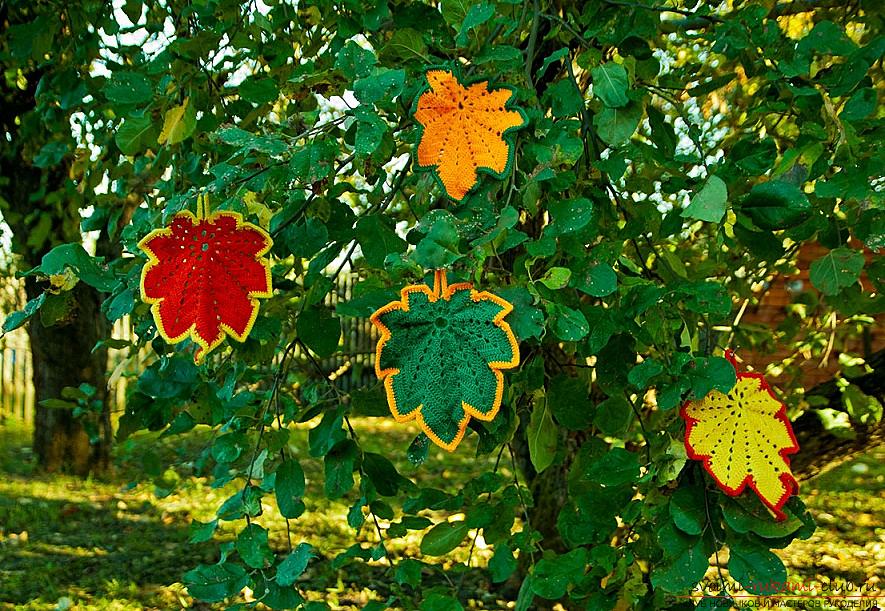 Such a motif, connected from fine yarn, will becomean excellent element of the dress, it can be used as a component of shawls or tablecloths. If you tie such a maple leaf out of thick threads and attach it to a fabric, it will become an excellent stand for hotter, and a variety of shades of yarn will allow you to choose a color suitable for the interior of the kitchen or dining room and make the room even more cozy.
Such a motif, connected from fine yarn, will becomean excellent element of the dress, it can be used as a component of shawls or tablecloths. If you tie such a maple leaf out of thick threads and attach it to a fabric, it will become an excellent stand for hotter, and a variety of shades of yarn will allow you to choose a color suitable for the interior of the kitchen or dining room and make the room even more cozy. 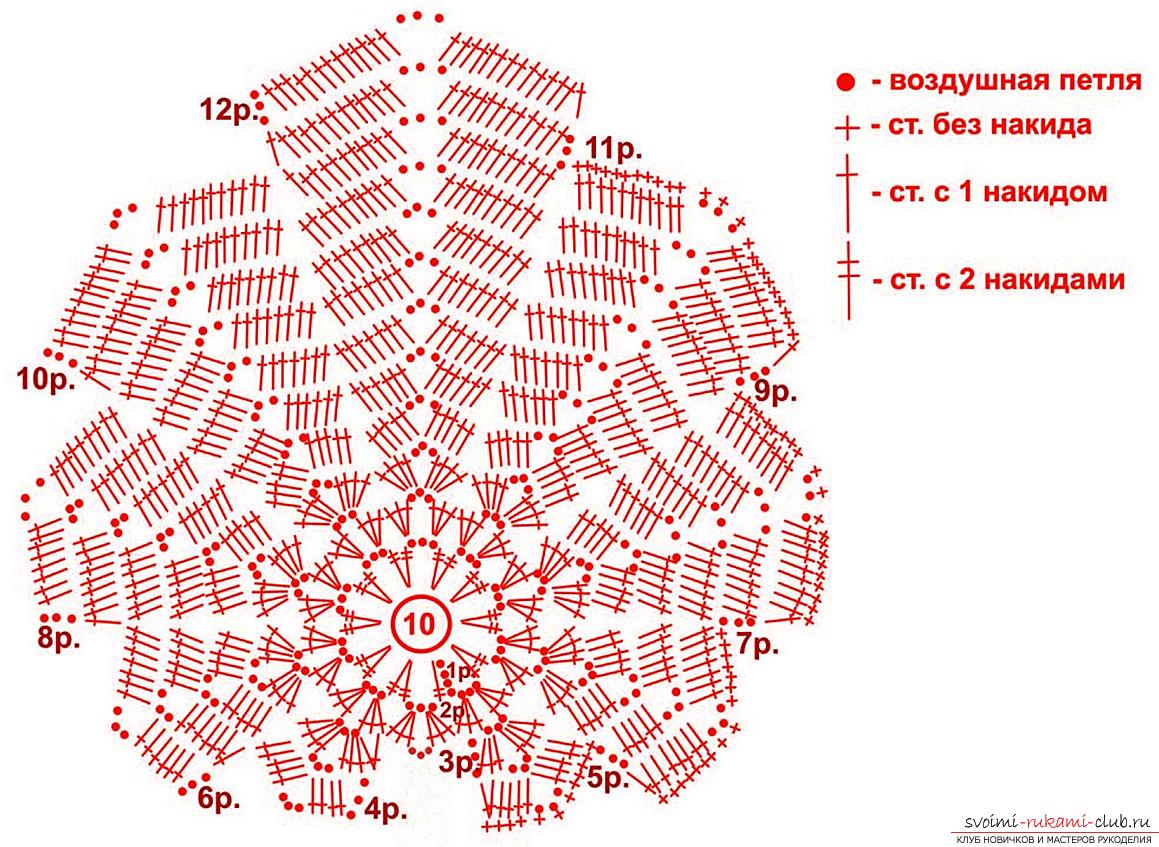
Close the chain of 10 air rings. loops.
First row. In each loop, tie a fragment (2 items with 2 nakidami + 3 air loops), replacing in the first case 1 tbsp. with 2 covers for 4 flights. lifting loops.
The second river. In each fragment of the previous row, tie (3 items with a crochet + 3 air loops + 3 sts with a cuff), replacing in the first case 1 st. with a crochet 3 air. lifting loops. Only 10 fragments.
Starting from the 3rd row the canvas is divided. Cut into 9 fragments (4 sts with crochet + 3 air loops + 4 sts with crochet), in the first case replacing 1 tbsp. with a crochet 3 loops of lifting, finish a row of 1 tbsp. with a crochet. Turn the work.
Fourth р. 3 air. lifting loops, in each of the 9 fragments to tie (5 items with a crochet + 3 air loops + 5 sts with a crochet).
The Fifth River. 1 air. lifting loop 11 tbsp. without crochet (all the loops tied in 1 fragment of the previous row), in each of the remaining 7 fragments to bind (6 items with a crochet + 3 air loops + 6 sts with a cuff), replacing in the first case 1 st. with a crochet 3 air. lifting loops.
The Sixth River. Start 3 Air. lifting loops. To knead 7 fragments (7 items with a crochet + 3 air loops + 7 sts with a crochet). Finish the series 2 tbsp. with crochet knitted with one top.
The seventh row. Start with 1 lifting loop and st. without a crochet in all the loops of one fragment of the previous row, 3 air. lifting loops, tying 5 fragments (8 items with a crochet + 3 air loops + 8 sts with a crochet). Finish the series 2 tbsp. with crochet knitted with one top.
The eighth row of 5 fragments (9th century with a cushion + 3 air loops + 9th century with a cuff), replacing in the first case 1 st. with a crochet 3 air. lifting loops.
Ninth row. 3 fragments and 10 st. with a crochet.
Tenth row. 3 fragments and 11 of Art. with a crochet, replacing in the first case 1 tbsp. with a crochet 3 air. lifting loops.
Eleventh row. 2 fragments and 12 tbsp. with a crochet.
The twelfth row. 1 fragment, start 3 air. lifting loops, 13 tbsp. with nakidami + 3 air. loops + 13 tbsp. with crochet.
Maple leaf in the original technique of non-stop knitting.  You can use it as a component of Irish lace or, attaching to a sirloin grid create a shawl. Perfect for decor bags.
You can use it as a component of Irish lace or, attaching to a sirloin grid create a shawl. Perfect for decor bags. 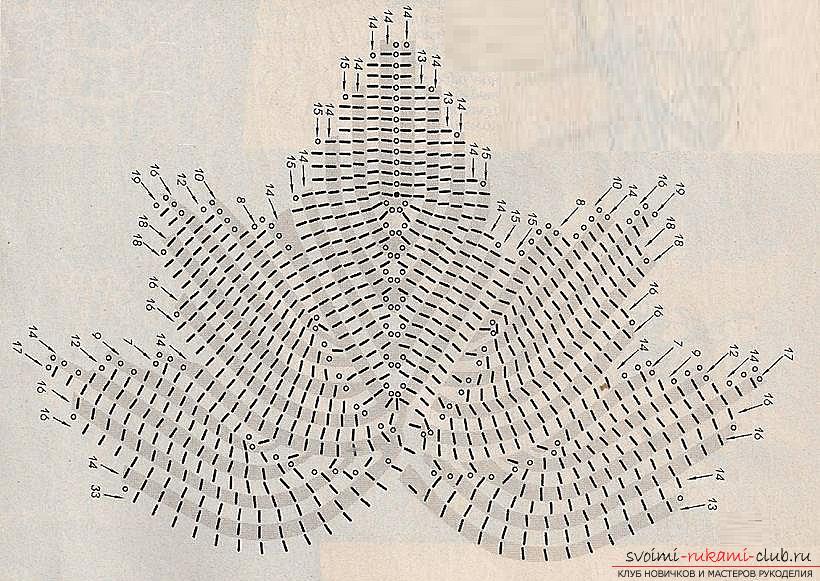 On the diagram, the black dot marks the beginning of the work.
On the diagram, the black dot marks the beginning of the work.
Type a chain of 15 air. loops.
First row. 1 air. lifting loop. To drink 13 tbsp. without a crochet, in the last loop is glad to tie (1 item without a crochet + 4 air loops + 1 st without a crochet), tie 13 tbsp. from the back of the initial chain.
Second row. 1 air. lifting loop, 13 tbsp. without a crochet, in an arch of air. loops to tie (2 items with a crochet + 4 air loops + 2 sts without a crochet), 11 tbsp. without a crochet.
8 rows of the central part of the leaf are to be patterned.
Ninth row. Start as usual 1 air. lifting loop, tying the specified amount of st. without a crochet, at the end of the row, tie 4 air. loops.
Tenth row. knitting of one of the lateral left pieces of the sheet begins. 1 air. lifting loop, 8 tbsp. without a crochet, 1 air. loop over st. without a row of rows below, 1 tbsp. without a crochet.
Eleventh row. 1 air. lifting loop, 10 tbsp. without a cape, 4 air. loops.
The twelfth row. 1 air. lifting loop, 14 tbsp. without a crochet, 1 air. loop over st. without a crocheting, 1 tbsp. without a crochet in art. without the 9th row.
Knit further according to the scheme fixing the even rows of Art. without a crochet to the station. without the 9th row.
To likewise similarly the second left part of the leaf, without tearing the thread, continue knitting art. without a crochet until the end of the 9th row (right), tie 4 air. loops.
Next row start 1 air. the lifting loop and start knitting the two right-hand pieces of the leaf similarly to the left.
Several more schemes of leaves crocheted. 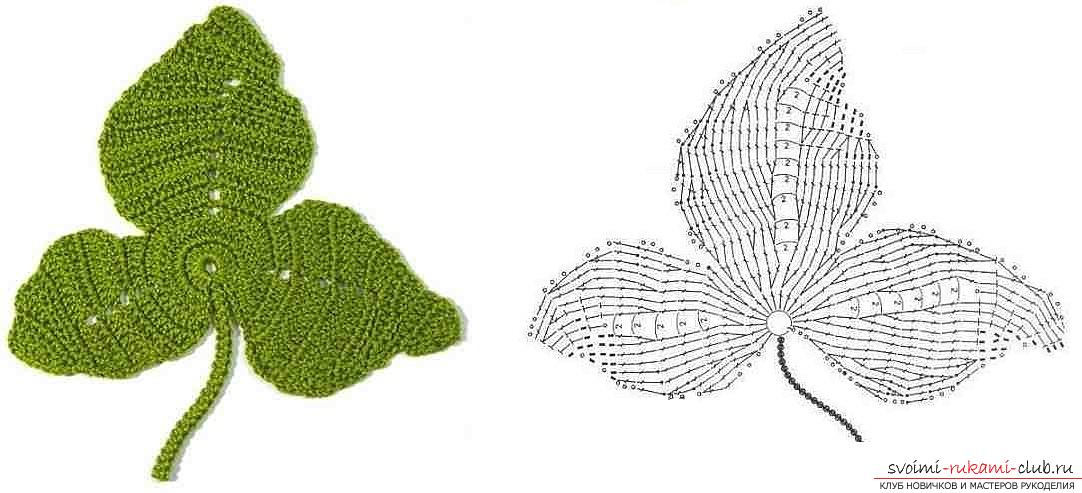
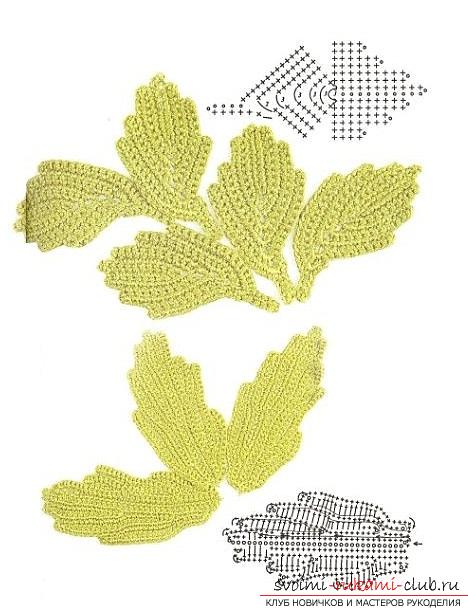
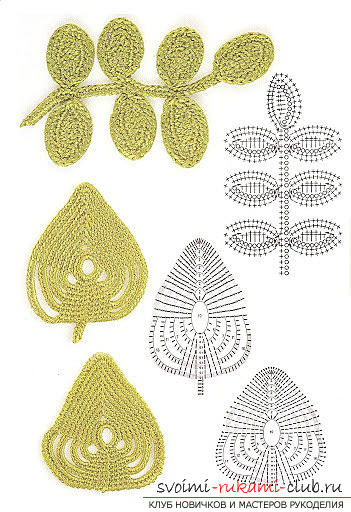 The original leaf is bound on a caterpillar cord.
The original leaf is bound on a caterpillar cord. 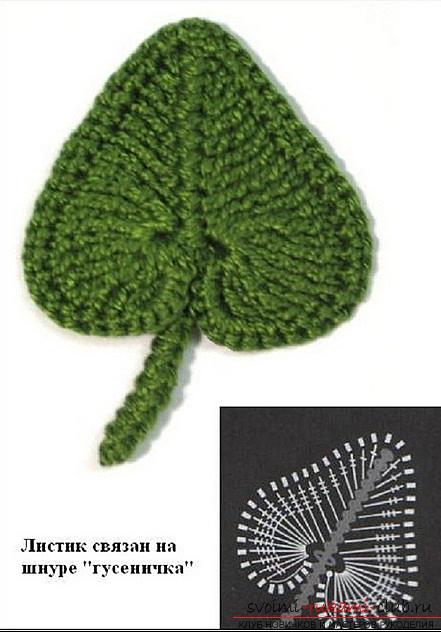
Comments
comments

 A very simple scheme will be understandable even for beginners, and an elegant shamrock can be used as an element of Irish lace or to create a composition of three-dimensional colors.
A very simple scheme will be understandable even for beginners, and an elegant shamrock can be used as an element of Irish lace or to create a composition of three-dimensional colors.  When knitting this leaf are used relief columns with 2 nakidami.
When knitting this leaf are used relief columns with 2 nakidami.  Starting from the 5th row of the middle, the petals kniteach separately. The length of the sheets varies due to the number of loops in the chain. For example, the smallest leaf is considered. Initially dialed from the chain of. for the petiole and the middle. Next, the middle knits in a circle in rows back and forth. Mid.
Starting from the 5th row of the middle, the petals kniteach separately. The length of the sheets varies due to the number of loops in the chain. For example, the smallest leaf is considered. Initially dialed from the chain of. for the petiole and the middle. Next, the middle knits in a circle in rows back and forth. Mid.  Such a motif, connected from fine yarn, will becomean excellent element of the dress, it can be used as a component of shawls or tablecloths. If you tie such a maple leaf out of thick threads and attach it to a fabric, it will become an excellent stand for hotter, and a variety of shades of yarn will allow you to choose a color suitable for the interior of the kitchen or dining room and make the room even more cozy.
Such a motif, connected from fine yarn, will becomean excellent element of the dress, it can be used as a component of shawls or tablecloths. If you tie such a maple leaf out of thick threads and attach it to a fabric, it will become an excellent stand for hotter, and a variety of shades of yarn will allow you to choose a color suitable for the interior of the kitchen or dining room and make the room even more cozy. 
 You can use it as a component of Irish lace or, attaching to a sirloin grid create a shawl. Perfect for decor bags.
You can use it as a component of Irish lace or, attaching to a sirloin grid create a shawl. Perfect for decor bags.  On the diagram, the black dot marks the beginning of the work.
On the diagram, the black dot marks the beginning of the work. 

 The original leaf is bound on a caterpillar cord.
The original leaf is bound on a caterpillar cord. 
